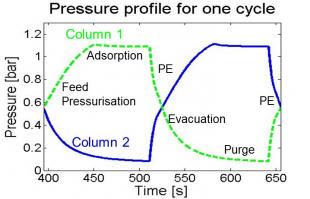CySim is a modular adsorption cycle simulator applicable to a wide range of adsorption system configurations. CySim is used to simulate a large range of experimental systems in our labs and is provided to our industrial partners in the Adsorption Research Industrial Consortium (ARIC).
Adsorption systems
- Multiple adsorption columns
- Connected by splitters, mixers, blowers, valves, tanks, ...
- Series of cycle steps: pressurisation, feed, purge, ...
Simulation of adsorption systems
- Dynamic system with many parameters and variables
- Non-linear Partial Differential-Algebraic Equations (PDAEs) with hyperbolic character
- Hyperbolic character leads to shock formation and propagation
- Different length scales: column, pellet, crystal, ...
- Different time scales: convection, macro- and micropore diffusion, adsorption, heat transfer, ...
- Convergence to Cyclic Steady State (CSS) can be slow
Features of CySim
- Modular system with different units: adsorption columns, valves, mass flow controllers, splitters, tanks, blowers, ...
- Arbitrary number of gas phase components
- Each unit has a hierarchy of models for various complexities of the mass, momentum and energy balances:
- Micropore mass transfer: equilibrium, Linear Driving Force (LDF), pore diffusion
- Macropore mass transfer: no resistance, Linear Driving Force (LDF), pore diffusion
- Isotherms: linear single-site Langmuir, dual-site Langmuir
- Momentum balance: no pressure drop, Ergun equation
- Energy balance: isothermal, non-isothermal with no resistance between fluid and solid, full non-isothermal
- Connecting units allow the integration into full plant flowsheet simulations, e.g. Unisim
- Arbitrary number and connection of units
- Simulate different cycle configurations by time events, e.g. switching of valves
- Unibed approach for the simulation of multi-column processes
- Discretisation schemes are tailored to the characteristics of the problem
- Flux-limited Finite Volume Method for the gas phase
- Orthogonal Collocation on Finite Elements Method for the solid phase
- Accelerate the convergence to CSS
- Model and discretisation switch
- Non-sequential cycle calculation: extrapolation algorithm
- Interpolation of the starting conditions
Related publications:
- Friedrich, Ferrari and Brandani: Efficient simulation and acceleration of convergence for a Dual Piston Pressure Swing Adsorption (DP-PSA) system. Ind. Eng. Chem. Res., 2013, 52 (26), pp 8897–8905.
- Banu, Friedrich, Brandani, Düren: A Multiscale Study of MOFs as Adsorbents in H2 PSA Purification. Industrial & Engineering Chemistry Research, 2013.
- Wang, Friedrich, Brandani: Characterisation of an automated Dual Piston Pressure Swing Adsorption (DP-PSA) system. Energy Procedia, in press.


